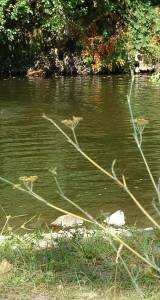Trees
:
The area arround Mosteiro Cimeiro is covered with pines and more
recently with eucalyptus. Of the older trees left some oaks ,
chestnuts, few "medronheiros" (Arbutus unedo with
comestible fruits used for liquor and alcohol).
The chestnut served as the basis of food like the wheat and corn
but nowadays it is used during the São Martinho -day
St Martin - when we taste the água-pé (the day os St
Martin, go to the cellar and taste the wine).
Olive trees grow all arround Mosteiro Cimeiro and are used to produce
olive oil but orange trees are allo acclimated.
Shrubs
:
In the bush there are estevas (Cistus
ladanifer with sheets covered with
aromatic resin),
carrascos (Quercus
coccifera with fruits called bolotas in Portuguese),
giestas ( Cytisus
striatus also called Portuguese
broom with flowers between May and June and toxic fruits),
moitas, urze and carquejas.
The carqueja (Pterospartum
tridentatum)
spontaneously grow in Portugal and has anti-oxidative
properties -
that is for the pharmacy. In most current use in the kitchen, a branch
of wild serves to cook the rabbit somehow to bring a taste of hare. In
the place of Carvalha we can find few flowers, pink
to purple
color which people called cucos (Paeoniaceae).
The mint hips also give a nice smell to the borders of the river.

